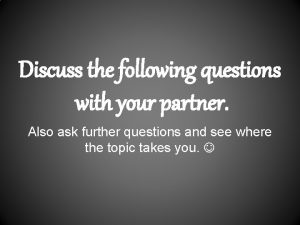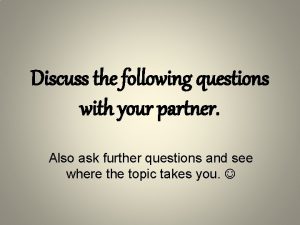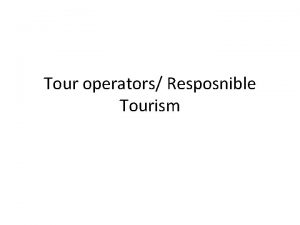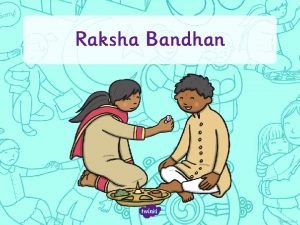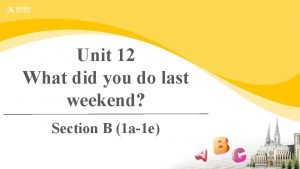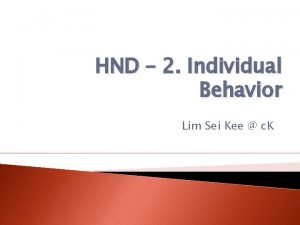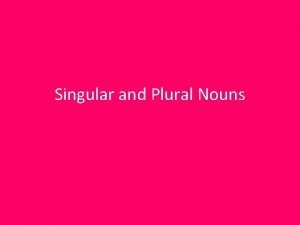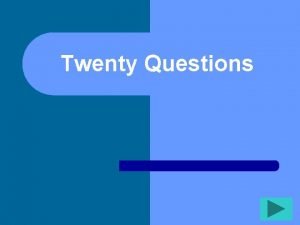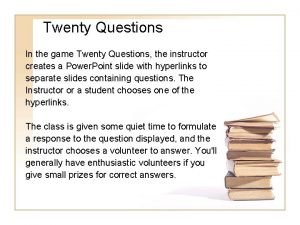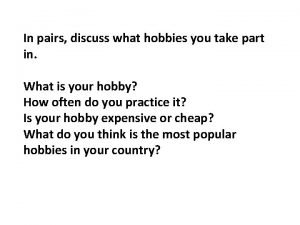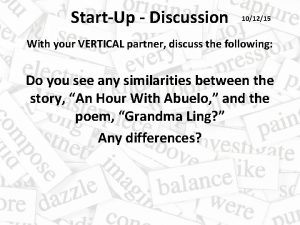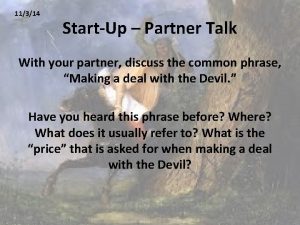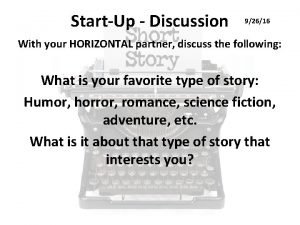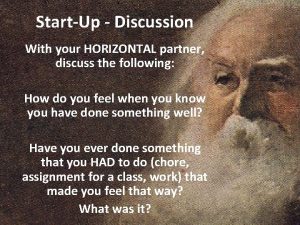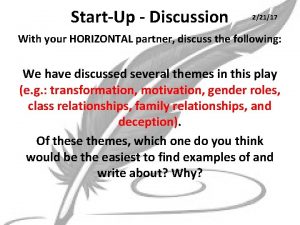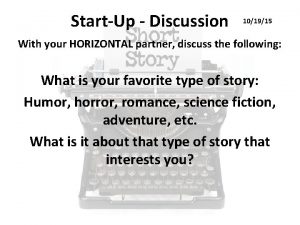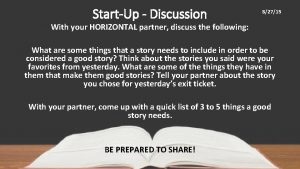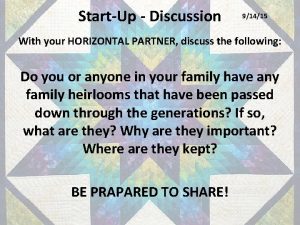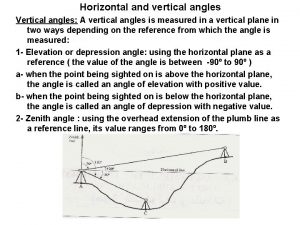StartUp Discussion 9815 With your VERTICAL partner discuss


















- Slides: 18

Start-Up - Discussion 9/8/15 With your VERTICAL partner, discuss the following question: In order to write a good summary of a story, what are some things that you MUST include? Come up with a list of 3 -5 things and BE PREPARED TO SHARE.

Start-Up - Writing Now, in your chart for TUESDAY, discuss the following question: In order to write a good summary of a story, there are some things that you MUST include. Tell me 3 -5 things that must be included in a good summary, and tell me WHY each one is important.

Today’s Objective By the end of the period, students will be able to: Be able to identify and give examples of the academic vocabulary related to the “Elements of a Narrative. ” Students will be prepared to write a one-paragraph summary of a short story, using the “Elements of a Narrative” as a guide. CCSS. ELA-LITERACY. W. 11 -12. 4 CCSS. ELA-LITERACY. W. 11 -12. 5

Summarizing a Story • Today we will be focusing on how to write a summary of a story. • We will be using some of our Elements of a Narrative to gather important information from the story. • In summary writing, we will write a sentence for each of these key terms.

Summarizing a Story Exposition Introduces the characters and setting • In summary writing, we have to begin by giving the reader a sentence of exposition; introducing the main character(s) and the setting of the story. • This is also when we will give the title (and author’s name, if it is known). • Example: The story “The Ugly Duckling” by Hans Christian Andersen is about a little duckling, living on a lake, who rises above the bullying of his friends and family. Partner Practice

Summarizing a Story Conflict The problem or struggle that drives the story's plot. • The next thing we do, in summary writing, is give the reader a quick explanation of the main conflict. • This can include some of the complications of the story as well, since they add to the conflict. • Example: The “ugly” duckling was picked on by the other ducklings because he looked different. Partner Practice

Summarizing a Story Climax The turning point, or the most important event. • The next thing we do, in summary writing, is tell the reader about the climax of the story. • Example: Then, one day, the duckling discovered another family of birds that looked just like him. Partner Practice

Summarizing a Story Resolution The story ends and the problem is solved. • Next, we tell the reader about the resolution or ending of the story. • Example: The ugly duckling found his true family and was never made fun of again. Partner Practice

Summarizing a Story Theme The main idea in a story or the lesson to be learned • Finally, we tell the reader about theme of the story. • This may include the main idea of the story and/or any moral or lesson to be learned. • Example: The story of the ugly duckling teaches us that we all have somewhere we fit in; we just have to find it. Partner Practice

Independent Work • You will be writing a one paragraph summary of the story, “The Love Letter” by Jack Finney. • To do this, you will be using the Summary Writing Worksheet (see assignments in Google Classroom). • Follow the instructions for each sentence and then rewrite your sentences in the space given. • Your summary paragraphs will be due by the end of class on Thursday.

Exit Ticket In your Exit Ticket Chart for TUESDAY, answer the following: Summary writing can be difficult for some people. It can be hard to decide what information, and how much information, to include. Do you think today’s lesson and exercise helped you to understand how to write a summary of a story? What was the most helpful part? Why?

Start-Up - Discussion 9/10/15 With your HORIZONTAL partner, discuss the following question: Think about the story, “The Love Letter. ” Do you think the conflict in the story is internal or external? What would you say is the climax of the story? Give evidence from the story to support your answer. BE PREPARED TO SHARE.

Start-Up - Writing 9/10/15 Now go to your Start-Up Chart and write about it: Think about the story, “The Love Letter. ” Do you think the conflict in the story is internal or external? What would you say is the climax of the story? Give evidence from the story to support your answer.

Today’s Objective By the end of the period, students will be able to: Identify and give examples of the academic vocabulary related to the “Elements of a Narrative. ” Students will be prepared to write a one-paragraph summary of a short story, using the “Elements of a Narrative” as a guide. CCSS. ELA-LITERACY. W. 11 -12. 4 CCSS. ELA-LITERACY. W. 11 -12. 5

Summarizing a Story • Today you will be writing a summary of “The Love Letter” by Jack Finney. • You will use some of our Elements of a Narrative to gather important information from the story. • In summary writing, you will write a sentence for each of these key terms.

Summarizing a Story 1. Exposition - Introduces the characters and setting 2. Conflict - The problem or struggle that drives the story's plot. 3. Climax - The turning point, or the most important event. 4. Resolution - The story ends and the problem is solved. 5. Theme - The main idea in a story or the lesson to be learned

Summarizing a Story • To do this, you will be using the Summary Writing Worksheet (see assignments in Google Classroom). • Follow the instructions for each sentence and then rewrite your sentences in the space given. • Your summary paragraphs will be due by the end of class today.

Exit Ticket Your exit ticket today is a completed, turned in, one paragraph summary of the story.
 Discuss the following questions with a partner
Discuss the following questions with a partner Discuss the following questions
Discuss the following questions Discuss these questions with your partner
Discuss these questions with your partner Discuss these questions with a partner
Discuss these questions with a partner Amateurs talk tactics professionals talk logistics
Amateurs talk tactics professionals talk logistics Your startup wants to implement an order fulfillment
Your startup wants to implement an order fulfillment Discussion of distillation
Discussion of distillation Stop testing your partner
Stop testing your partner Your partner is a reflection of you
Your partner is a reflection of you How did you … your last weekend?
How did you … your last weekend? Your romantic partner always uses the same shampoo
Your romantic partner always uses the same shampoo Your reliable partner slogan
Your reliable partner slogan Write the plurals compare with your partner
Write the plurals compare with your partner Prevent child abuse nevada
Prevent child abuse nevada 20 questions
20 questions Twenty questions board game
Twenty questions board game Nine basic physical abilities
Nine basic physical abilities Give us your hungry your tired your poor
Give us your hungry your tired your poor Austin siok
Austin siok
